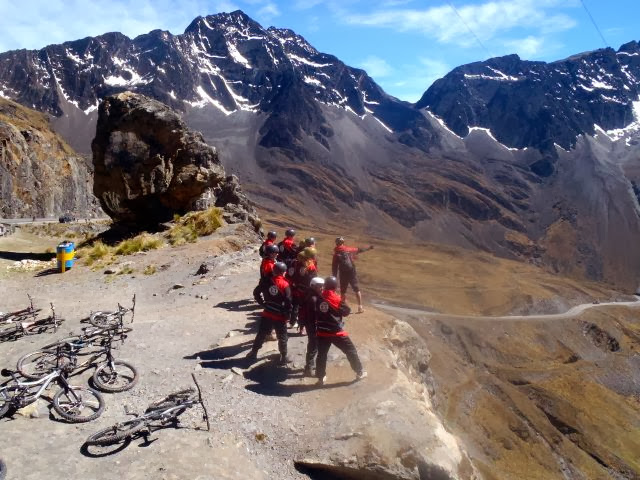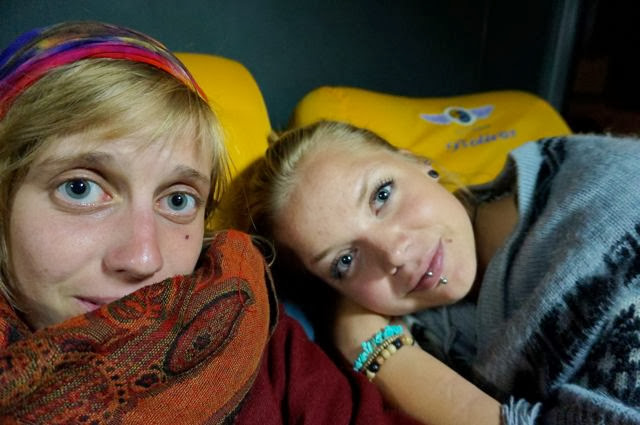For the first month at least I was feeling that I didn't really have a purpose here, that I could be doing so much more than I was doing and for a moment I started questioning myself and my competences. It felt like all the things I've learned through the many years of working with kids were useless and the things I'm good at (or thought I was good at) had no value. I would say that leaving the house for a few days made it easier to see which things we actually can do something about and which things just are out of our reach. Being able to talk with other volunteers and hear about their experiences also made me us realize that the challenges we've faced are common among volunteers and that we're not alone with our confused feelings.
 Now, after already being two thirds of our time here we've come to a point when we're beginning to find our places with the girls and among the staff at the house. The everyday life has become more easy-going and we've also got more structure to our work due to a schedule we made. We've also learned to take it more easy and realized that they need us here, even though it's sometimes feels just like a small favor for us to do. After all, it's not either good that the girls or the staff relies too much on volunteers as it's not guaranteed that there will be someone here all the time.
Now, after already being two thirds of our time here we've come to a point when we're beginning to find our places with the girls and among the staff at the house. The everyday life has become more easy-going and we've also got more structure to our work due to a schedule we made. We've also learned to take it more easy and realized that they need us here, even though it's sometimes feels just like a small favor for us to do. After all, it's not either good that the girls or the staff relies too much on volunteers as it's not guaranteed that there will be someone here all the time.I guess it has also become more easy to handle the things that in the beginning caused many sleepless nights. As I wrote before, these small human beings have gone through things that I don't even want to say out loud. We made a decision not to read their files because we're afraid that knowing everything about their past it would change the way we look at them. Though we can't totally avoid hearing things about them, and some things are also necessary to know. A few weeks back a new girl (13-years old) got placed here at Corazon Grande, so we got to experience that too and it's been interesting to see how she has adapted to the life here. How sad as it sounds I would say that many children growing up in this machismo-culture are better off at a foster home than with their own families. I think it says something that only here in Cochabamba, which is a city the size of Helsinki there are over 100 foster homes, not all as good as others. One thing that I can say for sure is that the girls here are very lucky, and thanks to this place have chance in life. This year Corazon Grande will actually have a student graduate, for the first time. She is the oldest one here, 18-years old and the best student at her school.
Since a few days back we've been working on a project to help Corazon Grande buy school materials for the girls - which we'll need your help with! You'll hear about it very soon. But before that I though it would be nice to share with you what our everyday life here actually is about and maybe reveal some moments behind the scenes!
 To make it even more challenging for ourselves we've taken a few things in our own hands and for example come up with "creative Sundays", which always are fun. Last Sunday we baked muffins that due to our not so awesome oven in the end looked like something baked in Chernobyl. But they tasted really good! Moreover the last four Sundays have been about making Christmas cards that need to be sent to all the supporters in Finland and Norway. Finally they are all done.
To make it even more challenging for ourselves we've taken a few things in our own hands and for example come up with "creative Sundays", which always are fun. Last Sunday we baked muffins that due to our not so awesome oven in the end looked like something baked in Chernobyl. But they tasted really good! Moreover the last four Sundays have been about making Christmas cards that need to be sent to all the supporters in Finland and Norway. Finally they are all done. |
| A tired baker taking a rest on our living room floor |

Basically our work here consists of hanging out with the girls, and it's often about being there when they need us. We help them with their homework, make handicrafts, teach English, play basketball or whatever comes up. We also hug, kiss, sing goodnight lullabies and read stories in Spanish - which often is quite hilarious. Those moments can not be caught on camera, as neither the many times we just hang out with the girls. Sometimes what they need is to get a little extra attention just for themselves, and maybe have someone listen to them read a story or just talk or fool around for a while.
Of course we also help our with household chores like cooking, baking, cleaning or whatever needs to be done. I would love to do a bit more but the staff here doesn't want to ask us for too much as we after all are just volunteers. In the beginning they didn't dare to ask us for help with anything but now they've started to realize that we actually like to help and have something to do.
 |
| Our two youngest girls (3 and 5-years old) helping out in the kitchen |
 |
| Fresh pan! |
 |
 | |
| Picking manzanilla-flowers for the evening maté |
 |
| Teaching English |
 |
| A tired student learning the alphabet in English |
Every Monday Julia and I do a night shift at Casa Baste, as there is no staff present after dinner. The first times it was exciting, though quite chaotic as we had no idea what to do and didn't understand so much of what the girls were trying to ask or tell us. Now it's already become a routine and I would say that we handle it really well, considering that we always get everyone to bed at night and manage to get them up, showered, dressed, combed and fed before they leave to school. All of this happening in Spanish, at 6 o'clock in the morning.
 About twice a week it's our duty to take two of the girls home from their ballet class in the evening, which is always and adventure. The girls are sisters, and they are always coming up with something! They also love to sing and show off so it's always very entertaining spending time with them.
About twice a week it's our duty to take two of the girls home from their ballet class in the evening, which is always and adventure. The girls are sisters, and they are always coming up with something! They also love to sing and show off so it's always very entertaining spending time with them.Another important job we have is driving the girls and the staff to church every Sunday morning. All 25 girls + a few adults in a car for 14 people, it's a space miracle! No one from the staff, except Angel a.k.a Papi knows how to drive so in this matter they depend on the volunteers as Papi doesn't work in the weekends. During the week he's the one who takes the girls to and back from school, drives them around, takes care of grocery shopping and other practical things. I have to say that Papi Angel is irreplaceable, and also the only man who works at the house.
 |
| Still about 10 people missing from the car... |
 |
| The girls fooling around with Papi |
That same night the car broke down on the way home. So we ended up being stuck in the car waiting for help for two hours in the middle of a storm on the main road to Tiquipaya, together with a 11-year old. Eventually we got help, got the car running again and drove straight back to pick up the girls from the party, three hours later.And this happened on our second week here.
 |
| Entertaining ourselves in the car |
 As I've
already mentioned a couple of times in the past they eat a lot of cake
here in Bolivia. Also at our house it feels like we're having cake all
the time, and every second week it's someone's birthday or some other
fiesta. During fiestas we always eat all together, and there's always a
huge cake! According to the tradition the one being celebrated has to
take the first bite from the cake, and always gets pushed face forward
straight in to the cake.
As I've
already mentioned a couple of times in the past they eat a lot of cake
here in Bolivia. Also at our house it feels like we're having cake all
the time, and every second week it's someone's birthday or some other
fiesta. During fiestas we always eat all together, and there's always a
huge cake! According to the tradition the one being celebrated has to
take the first bite from the cake, and always gets pushed face forward
straight in to the cake. 
 |
| Double birthday! |

 Last but not least I want to mention our furry friends at Corazon Grande. Dogs are mostly considered as watchdogs and not pets around here, but I have to say that the dogs at our house are far from scary watchdogs. Since the first time we stepped inside the gates to this place we have been very good buddies with Sasha and Djeyna, our dogs. I don't think I need to say more about the characters of these dogs, I'll let the pictures tell the rest.
Last but not least I want to mention our furry friends at Corazon Grande. Dogs are mostly considered as watchdogs and not pets around here, but I have to say that the dogs at our house are far from scary watchdogs. Since the first time we stepped inside the gates to this place we have been very good buddies with Sasha and Djeyna, our dogs. I don't think I need to say more about the characters of these dogs, I'll let the pictures tell the rest.  |
| Morning Sasha |
 |









































































